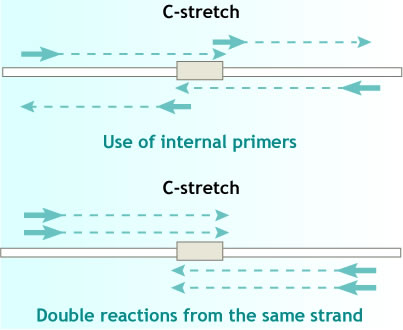Archival Notice
This is an archive page that is no longer being updated. It may contain outdated information and links may no longer function as originally intended.
Home | Glossary | Resources | Help | Contact Us | Course Map
Heteroplasmy is when an individual exhibits more than one mtDNA (mitochondiral DNA) type. This phenomenon is usually observed as a single difference at one position exhibiting either two or more bases or a length difference often seen in a polycytosine rich region (C-stretch). Single base heteroplasmy has been documented, most notably in the identification of Tsar Nicholas II.15 Length heteroplasmy in the D-loop region has been described in both HV1 and HV2.16, 17, 18 Whereas heteroplasmy may complicate interpretation, it actually becomes a "signature" of the donor's mtDNA haplotype. Heteroplasmy can, therefore, strengthen the identification of a sample.
Point mutations or deletions in mtDNA usually increase with age. Defects in mitochondrial function produce a wide range of human diseases and can be caused by mutations within the mtDNA. The first mtDNA mutation discovered to be the cause of a disease was Leber's hereditary optic neuropathy (LHON).19 Identified in 1988, LHON is a maternally inherited form of adult-onset blindness due to death of the optic nerve. Point mutations are relevant because the person's mtDNA type can change with age.
Additional Online Courses
- What Every First Responding Officer Should Know About DNA Evidence
- Collecting DNA Evidence at Property Crime Scenes
- DNA – A Prosecutor’s Practice Notebook
- Crime Scene and DNA Basics
- Laboratory Safety Programs
- DNA Amplification
- Population Genetics and Statistics
- Non-STR DNA Markers: SNPs, Y-STRs, LCN and mtDNA
- Firearms Examiner Training
- Forensic DNA Education for Law Enforcement Decisionmakers
- What Every Investigator and Evidence Technician Should Know About DNA Evidence
- Principles of Forensic DNA for Officers of the Court
- Law 101: Legal Guide for the Forensic Expert
- Laboratory Orientation and Testing of Body Fluids and Tissues
- DNA Extraction and Quantitation
- STR Data Analysis and Interpretation
- Communication Skills, Report Writing, and Courtroom Testimony
- Español for Law Enforcement
- Amplified DNA Product Separation for Forensic Analysts


